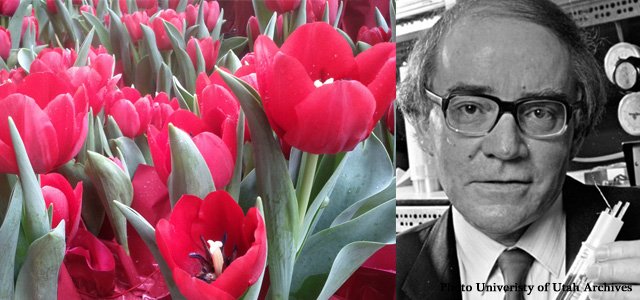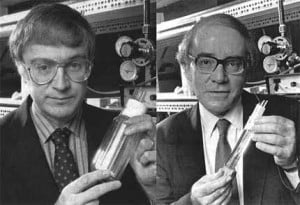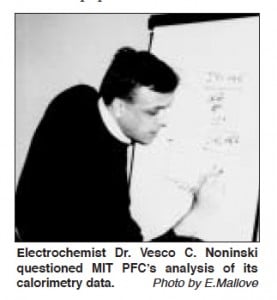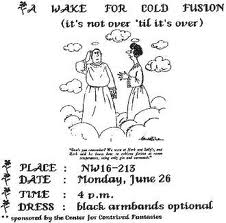“Martin was probably the greatest scientist that I have ever known… I believe that eventually truth will win out. I don’t know how long it might take, but eventually Martin will be honored by many for his great scientific work in the cold fusion field.” —Dr. Melvin Miles
“The world is slowly, but inexorably, moving toward a better place because of Martin Fleischmann’s transit through it.” —Dr. Mitchell Swartz
“He was chosen to pay the price for success. Now he has peace and the rest of us have the responsibility not to let his sacrifice be in vain.” —Dr. Edmund Storms
“Martin Flesichmann was one of the greatest scientists that ever lived.” —Dr. George H. Miley
Martin Fleischmann has left the planet, on his way to better beyonds where knowledge is total and awareness a mere triviality in a larger existence.
New Energy Times has reported here that he passed away in his home in the United Kingdom Friday, August 3, 2012 with his family in attendance.
Born March 29, 1927, Dr. Martin Fleischmann was lauded as one of the greatest electrochemists that ever lived. Co-discoverer of cold fusion with his partner Stanley Pons, the pair embarked on an epic scientific journey that adds their names to the list of greatest scientific figures in history.
Enduring decades of ostrasization from their conventionally-thinking peers, both Drs. Fleischmann and Pons have been vindicated for their claims as cold fusion, also called lattice-assisted nuclear reactions (LANR), and low-energy nuclear reactions (LENR), has been reproduced hundreds of times by multiple types of systems.
Cold fusion offers a viable alternative to the continued use of dirty fossil fuels and nuclear power that uses radioactive materials leaving waste so dangerous, it threatens biological systems worldwide. Cold fusion presented an ultra-clean energy-dense source of power using as fuel hydrogen from water. The development of both the science and technology of cold fusion was almost extinguished by a coordinated effort from hot fusioneers and conventional energy physicists in 1989 who sought to discredit their results, and succeeded in delaying the development of clean energy technology for two decades.
It has been a small group of intrepid researchers from around the globe that have continued the work, bolstering the data with over-two decades of experimental confirmation that cannot be refuted. Commercial development of cold fusion technology in the form of hot water heaters and steam generators is currently ongoing by a new generation of scientists that were inspired by initial announcements of Drs. Fleischmann and Pons.
Andrea Rossi, inventor of the Energy Catalyzer, has said in an interview with James Martinez that ‘it was the announcement of their discovery in 1989 that was the “spark that ignited the fire”’. [read]
In an interview with Ruby Carat, hot- and cold-fusion pioneer Dr. George H. Miley remarked that “Martin Flesichmann was one of the greatest scientists that ever lived.”
Referring to the wild emotional backlash from physicists who felt their research threatened by the discovery, Dr. Miley said, “Any personal ramifications of individuals is so unfortunate. But you know that’s happened to many people in the field. The field has had a series of tragic events occur where workers in it have been maligned. Emotions grew so high. It should have been done in a scientific fashion, it would’ve been so much better. But I have nothing but the highest respect for Pons and Fleischmann, such great scientists, anyone would be privileged to follow their lead in science.” [read]
Cold fusion researcher and author Dr. Edmund Storms responded to the news of Martin Fleischmann’s passing with, “I was not part of his major field of interest, so my role in the LENR field was not important to him. Nevertheless, I’m sad that he paid such a high and unreasonable price and is now gone. His efforts to make the CF effect work could just as well have been as unsuccessful as experienced by most attempts at replication. But he was chosen to pay the price for success. Now he has peace and the rest of us have the responsibility not to let his sacrifice be in vain.”
He was further quoted here:
“Martin demonstrated that Nature has a diabolical plan. He and Stan were
not the first to cause the LENR process but they were the first to attract
attention. For that, they paid the price Nature always extracts when a
great discovery is made. They attempted the “impossible” based on a flawed
model, using lucky material that most people could not duplicate, and
stirred up a firestorm of antagonism from people who were their colleagues
and friends. They were rejected for reasons both ignorant and self-serving
by people who we all thought should know better. Sadly, Martin did not
live long enough to say he told them so, and have the last laugh.
Hopefully, the rest of us can complete the process and gain acceptance for
what he and Stan paid such a dear price to make known. We will all miss
the man who led us into this crazy field.” —Edmund Storms
Scientist and designer of the NANOR device currently on public display at the Massachusetts Institute of Technology, Dr. Mitchell Swartz of JET Energy has written:
“The world is slowly, but inexorably, moving toward a better place because of Martin Fleischmann’s transit through it.
He was involved in two of the most important things in life: learning and teaching. He taught at King’s College, Durham University (later, University of Newcastle upon Tyne) and University of Southampton. He discovered and taught surface enhanced Raman scattering effect and the achievement of high energy Cold Fusion in a palladium lattice
Martin and his two partners were the first to achieve the purposeful attainment of cold fusion (fusion of deuterons to helium 4) using applied electric fields and a lattice in salty heavy-water.
As the cat whisker junction is to the Internet, Dr. Martin Fleischmann’s contribution in cold fusion will be to space travel, fully powered artificial internal organs, and much more.” —Mitchell Swartz
In a recent interview with Ruby Carat, former-Navy researcher and Professor of Chemistry Dr. Melvin Miles remarked that the data analysis Martin Fleischmann did on their collaborations that confirmed his own calculations was like none other in the world in it’s detailed meticulousness. “Only Martin could have done an analysis like this”, he said, calling him “one of the greatest scientists ever”. [read]
Dr. Miles responded to the news today re-iterating his assessment:
I have had many communications from Martin starting in about 1994 and have these here at home. Martin was probably the greatest scientist that I have ever known. I hope that this will someday be recognized by many others. I have spent many hours, days, and weeks studying his calorimetric equations and methods. He was far ahead of any other group in his calorimetric designs, modeling, and data analysis. This will be the topic of one of my ICCF-17 presentations and what led to my recent question for him. One of the main inspirations for me to continue with the difficult cold fusion research and calorimetry was my recognition of Martin Fleischmann’s brilliance that shown so far brighter than that for any Caltech, MIT, or Harwell scientist who worked with calorimetry.
Martin Fleischmann visited me here in California in October of 2000, and we took him to see again his favorite spot in Yosemite National Park. It was always a pleasure to spend time with Martin and to learn from him. I will greatly miss him. I believe that eventually truth will win out. I don’t know how long it might take, but eventually Martin will be honored by many for his great scientific work in the cold fusion field. —Melvin Miles
The courage and character of Martin Fleischmann, along with his pal Stanley Pons, and including Eugene Mallove and all the scientists who continued their bold and honest inquiry into the workings of nature for the benefit of humankind, are the inspiration for Cold Fusion Now, and remain the heart of our existence.
With respect to his family, the cold fusion/LANR/LENR community, and all peoples of the globe who long for freedom, we dedicate ourselves to the same tenacious quest for the clean energy to power a green and peaceful human future.
Martin Fleischmann will emerge again when the new documentary by 137 Films called “The Believers” is finally released later this year. Until then, here is Martin Fleischmann speaking in 1999 at the American Chemical Society meeting on the 10-year anniversary of the announcement of cold fusion. He is introduced by Dr. Melvin Miles, a long-time researcher who collaborated with Dr. Fleischmann on many investigations.
Thank you to the New Energy Foundation for archiving this historical sequence.
With Love and Peace to You Martin. Thank You.
More wishes from around the world:
The Deep Reach of Martin Fleischmann
Related Links
New Energy Times posted this obituary here.
Martin Fleischmann and Stanley Pons in their own words by Ruby Carat March 23, 2012
Thank you Martin Fleischmann; Thank you Stanley Pons by Ruby Carat March 23, 2011
1994 BBC doc Too Close to the Sun profiles early history of cold fusion underground by Ruby Carat June 7, 2012
The Telegraph on Martin Fleischmann August 9, 2012










